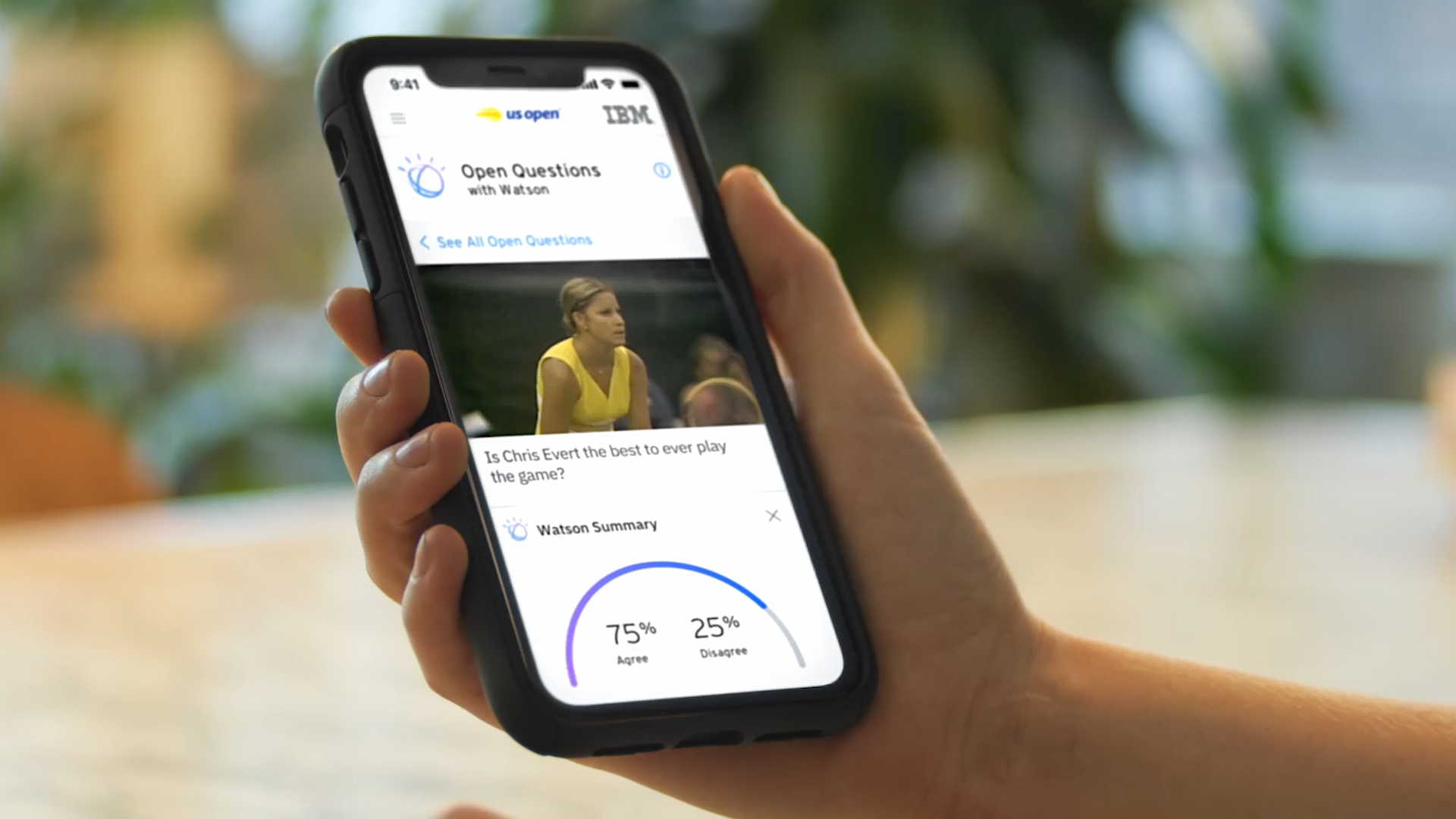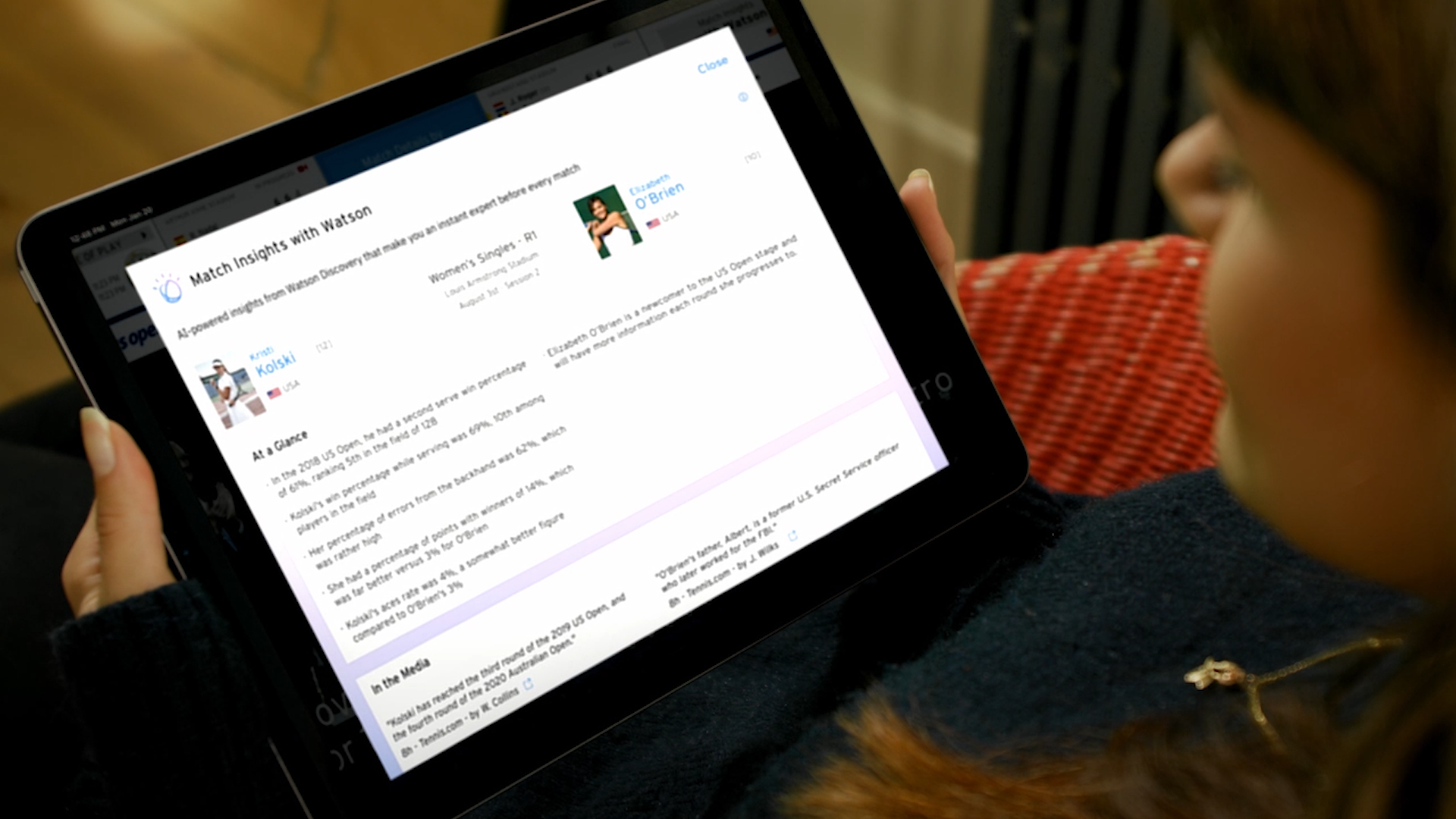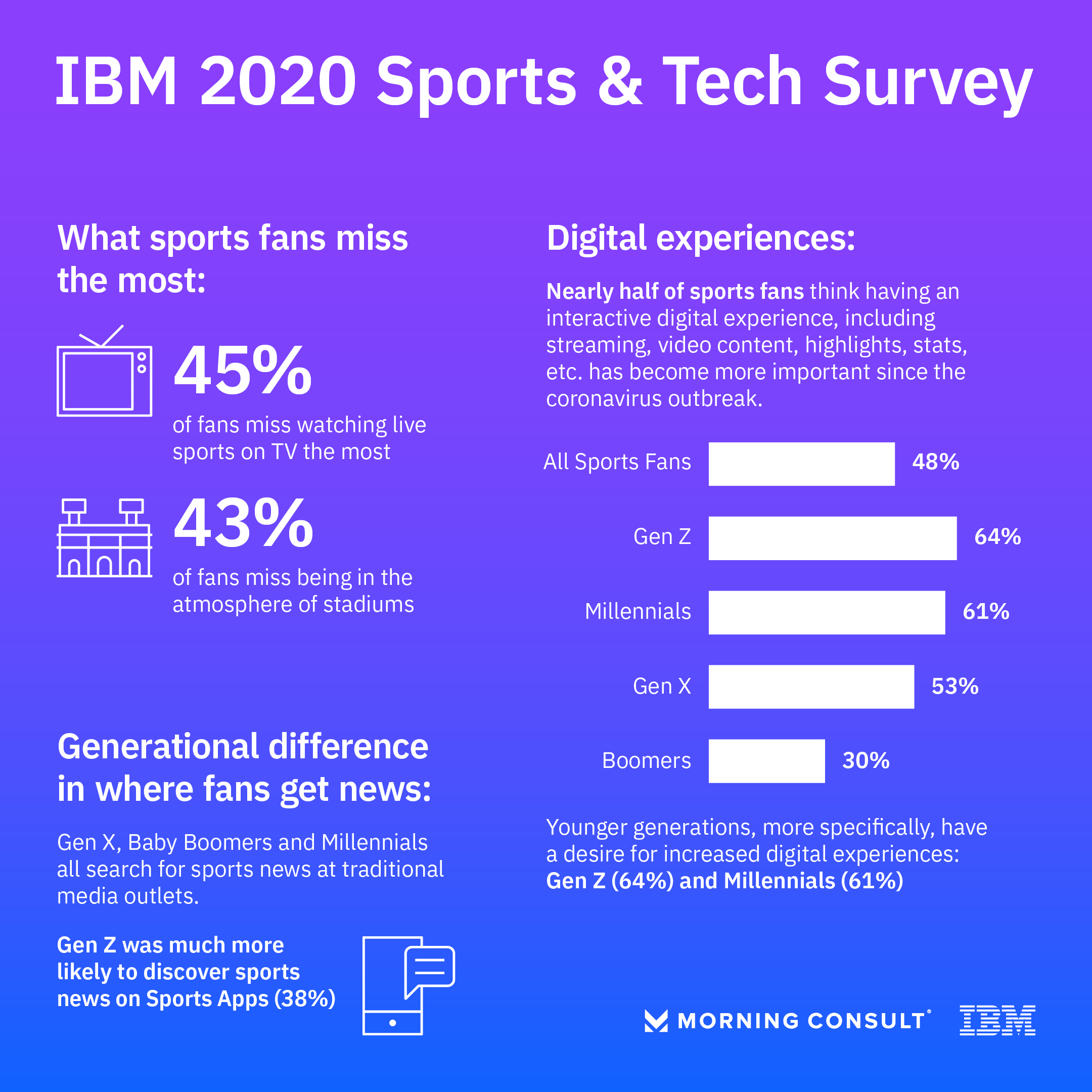US Open 2020
Feature Story: In the Era of Empty US Open Seats, IBM and AI Can Help Fans Stay Engaged
By Trish Hall
As the US Open gets underway in New York this week, the world’s top tennis players are performing in front of empty seats—not the 800,000 or so fans who would normally fill the Billie Jean King National Tennis Center during the two-week tournament.
But tennis fans will be watching from home on televisions, computers and the US Open app. To connect them even more deeply to the matches, IBM, in collaboration with the tournament’s host, the United States Tennis Association (USTA), has developed new, immersive interactive features using IBM’s AI and Watson capabilities.
With spectator sports being played with no fans present, and no clear indication of when crowds can return to stadiums and arenas, IBM Services’ business design arm— IBM iX—and USTA sense that the fan experience may never again be quite the same. Based on their years of working together, and IBM’s experience with many other sports and sporting events, they know that digital technology can have a central role to play in keeping fans involved, even once the grandstands start filling back up again.
“Fans are sports starved right now,” said Shannon Miller, IBM’s iX Practice Lead. “They haven’t had very much to watch. If they are not able to come to the event, having the engagement platform is more important now than it has ever been.”

A Fast Virtual Pivot
In a typical year, the USTA digital team and the IBM iX team work together remotely, building the platforms and new user experiences until August, when they would all meet in a war room at the stadium. But this year, as they were deep into development on the platforms, the team had to halt and pivot. Only in mid-June did the IBM team learn that US Open would become the first major tennis tournament to be held since the pandemic disrupted professional sports. And only then did the USTA-IBM team know that tech creation would need to focus on a virtual fan experience.
The team took what they already knew about delivering next-generation digital experiences to focus on what was essential this time: engaging fans at home. To do so, they employed the IBM Garage Methodology to conceive, design and test the new fan experiences and fast-track their deployment in 12 weeks.
“When you go to an event,” said Miller, “you feel like you’re interacting with your team or favorite player. You even feel like you can impact the outcome.” Now, digital elements are an important way to keep people engaged and following sports. Just watching might not be enough, if the watching is done virtually.
“What’s the type of content we can bring them so they don’t leave, so they stay engaged?” he asked. “You can’t do that with manual efforts alone like retweeting. It has to be automated, you have to use next-gen tech.” And to make it widely available, at scale, to fans around the world, you need a robust, reliable platform, he said.
The importance of a virtual, interactive experience has intensified because professional sports organizations cannot afford to lose their fans—which is a rising risk the longer the pandemic continues. An IBM Institute for Business Value survey of 2,500 U.S. consumers in August found that 53 percent said they are unlikely to attend a live sporting event this year. And 13 percent said they would probably never attend one again.
Against that worrisome backdrop for the sports industry, the USTA-IBM team knew that to keep fans involved, it would have to come up with something completely different this year. It would also need to engage people who might not know a lot about tennis, but are sports enthusiasts hungry for the resumption of any new athletic competition.
“We were seeing a lot more casual viewers of the classic match replays,” said Kirsten Corio, who directs digital strategy for the USTA. “Maybe they were at home and bored, starved for new sports content. We hope that this will make those more casual fans more educated about the sport and the tournament.”
The two new interactive AI-enabled innovations are Open Questions With Watson, and Match Insights With Watson Discovery. Both will be available on the USTA’s USOpen.org website.
Open Questions with Watson will employ Natural Language Processing (NLP) capabilities in IBM's Watson Discovery, IBM Project Debater and custom AI algorithms to generate and moderate a public conversation during the tournament over questions like "Is Serena Williams the best player in tennis?'' and "Does Pete Sampras have the best all-around tennis game?"
Match Insights with Watson, providing a fan tip sheet for each match, has used Watson Discovery NLP technology and custom Natural Language Generation algorithms to pore over millions of written articles from the news, sports journalism and other sources, to glean the most relevant facts and insights, and write short, data-rich articles to raise the curtain on each match-up.
The innovations are all the more noteworthy because of how quickly they needed to be designed and implemented.

A Well of Experience
Although IBM has been providing technology support to USTA for the US Open for 29 years, the main emphasis in the past was on assuring a successful, seamless website and mobile app experience. This time, with only weeks to prepare, they needed make it an immersive virtual experience. Fortunately, because the IBM iX team has created digital content to support ESPN Fantasy Football and other sports events, it could draw on extensive virtual sports expertise.
Open Questions with Watson Discovery will, over the course of the tournament, post seven questions for fans to answer. Other questions, besides the ones on Williams and Sampras, will include, “Is Roger Federer the best men’s tennis player ever?”
Natural Language Processing, based on IBM Research technology, will analyze the opinions submitted by fans. Narrations will be generated for each claim, using data sources like Watson Discovery News and Wikipedia as well as input from fans. The answers will be analyzed by AI from IBM Research, and tennis celebrities like Chris Evert and Andy Roddick will respond.
“The goal of the open question project is to stimulate a conversation about popular tennis topics,” said Aaron K. Baughman, a Distinguished Engineer with IBM iX who focuses on artificial intelligence and emerging technologies. “We’ll be mining the fan content as well as archives to write a narration around each of these questions.”
In Match Insights, tennis fans will get deep background, created by AI gathering biographical information for each player, including their historical performances.
“We wanted to put Watson technology to use,” said Jenna Miller, a senior consultant at the IBM iX Studio in Atlanta. “It tackles hundreds of thousands of articles and facts about a player. It’s super cool to be able to bring that into one place.” Natural Language Generation will take the data and produce text about each player, mining Watson Discovery News, Wikipedia, and expert sources like USOpen.org.

Unexpected Insights
Scanning and using AI to capture the essence of thousands upon thousands of sources turns up data that even skilled sportswriters might not spot.
“You have this assumption, when you’re watching the pros, that the dominant players are going to be the best at absolutely everything,” said Gray Cannon, who leads the analytics initiatives for the iX Events practice. “But they have weaknesses too. It’s interesting to uncover those. There are players who are less known who are in some respects even stronger than Williams and Federer. Being able to compare the data in that way was really interesting for me.”
For example, some of the top-ranked players actually have much higher percentage of unforced errors than some of the less heralded pros—the sort of insight that might, afterward, help explain a big upset or two.
Cannon especially liked the project because he grew up playing tennis, competing through high school. “It’s a dream come true for me to mix that with how much I enjoy poring over the statistics, to be able to bring the kind of insight I enjoy to someone who may not do data analysis in the same way.”
IBM’s Shannon Miller said it was possible to create the new products on such a tight timetable because the technology was in place, particularly the hybrid cloud platform that enabled dispersed teams to collaborate so effectively. And the history mattered.
“It’s important for us in iX to be able to pivot on a dime. If they trust us with their platform, we can make changes really fast,” said Jenna Miller. “They know we can lead them to a great fan experience with the combination of the build, the run, and the innovation.”
The new, immersive fan content seems likely to continue evolving in the future. Even in a regular year, USTA’s Corio said, 10 million people use the site during the U.S. Open. With the right engagement, she said, that number can grow. “If we see that any of the technology really has traction, that will provide the fuel we need.”